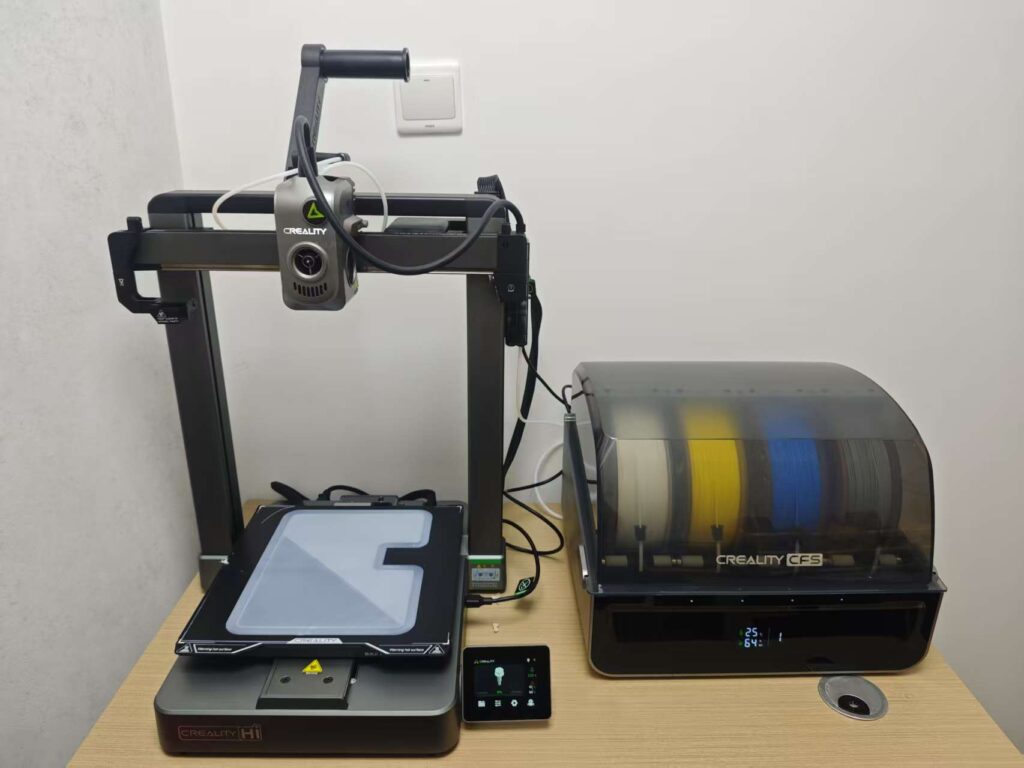
Creality Hi Combo Review: Multi-Color 3D Printing Made Simple for Beginners and Families
If you’ve ever dreamed of creating vibrant, multi-material 3D prints without a steep learning curve, the Creality Hi Combo(A) might be the machine for you. In this Creality Hi Combo Review, I’ll share not just the official specs, but also my personal journey — one that started with a simple 3D printer and ended with a very happy kid.
My son, Danny, has been fascinated by 3D printing ever since we brought home a KOKONI 3D printer. It was perfect for beginners — compact, quiet, and easy to use. But after months of printing simple models in one color, Danny was itching for something more advanced. The KOKONI was starting to feel like training wheels, and he wanted the “big bike.”
That’s when I decided to surprise him with the Creality Hi Combo(A) as a gift — a machine that promised 16-color printing, high speeds, and all the bells and whistles that would let his creativity truly shine.





Table of Contents
We Like
Sturdy all-metal frame
Beginner-friendly setup with auto bed leveling
Vibrant 16-color printing without painting
RFID filament detection
Creality Cloud remote monitoring & timelapse
Good print accuracy with PLA
We Don't Like
Heavy and can cause table vibration
Slower multi-color print speed
No automatic warning for missing supports
Instruction manual could be clearer
Specification

- CFS×4 for Up to 16-Color Printing
- 95% Pre-Assembled – Easy to Start
- 260×260×300 mm³ Build Volume
- Up to 500 mm/s Fast Print Speed
- Auto-Calibration with One Tap
- Clog-Free & Quick-Swap Nozzle
Unboxing & Setup Experience
Creality ships the Hi Combo(A) in sturdy, foam-padded packaging. Everything arrived in perfect condition despite traveling through the logistics gauntlet. The printer comes 95% pre-assembled, and while Creality claims quick setup, it took me about 30 minutes from unboxing to first print.
To be fair, this was my first-ever installation of a full-size 3D printer, and the manual wasn’t crystal clear — I had to repeat a few steps. Once powered on, though, the auto bed leveling worked flawlessly. No manual tweaking was needed, which is a huge relief for beginners like me and exciting for kids like Danny, who just want to start printing.
Build Quality & Design
The all-metal frame feels rock-solid — but it also means the unit is heavy. I initially placed it on an IKEA table, which wasn’t the best choice; printing at high speed made the table shake. Moving it to a sturdier surface solved the issue.
The 3.2-inch foldable touchscreen is responsive and intuitive, though its height placement depends on your table setup. Noise levels are noticeable but not unbearable — fine if you’re in the next room, less so if you’re sitting right beside it. Danny didn’t mind; he actually liked hearing the “robot” working.
Printing Performance
For our first projects, we used PLA 0.2mm filament. The results? No stringing, no layer adhesion problems, and no warping. The print precision lives up to the promised <0.1mm accuracy.
Single-color print: 38.63m of filament, 4h 25m 48s — ~2.42 mm/s average speed
Multi-color print: 155.96m of filament, 1d 0h 8m 38s — ~1.79 mm/s average speed
Multi-color printing was slower (about 74% of single-color speed), but the payoff was worth it. Danny’s face lit up when he saw his first multi-color model — “It’s like magic,” he said, “but better than painting!”
Smart Filament Management
The RFID filament detection system correctly identifies filament type and color, which means no guessing games for Danny. I haven’t yet tested run-out detection in action, but it’s there for peace of mind.
The printer also has 20W drying power and airtight filament storage, though I haven’t tested these with hygroscopic materials like nylon. For now, we mainly use PLA and PETG, which don’t absorb moisture as quickly.
Smart Features & Connectivity
The built-in Creality Cloud integration is surprisingly fun. Danny loves that he can watch the printer remotely, and latency is minimal. The timelapse webcam works well for long prints, and WiFi connectivity has been stable so far.
The 8GB EMMC storage is more than enough for our light use. If Danny’s projects get bigger in the future, we’ll explore external storage.
Ease of Use & Software
The bundled Creality Print 5.1 slicer is beginner-friendly and supports 16-filament 3MF slicing. For us, the interface was easy to understand, even for multi-color jobs.
One issue we ran into: forgetting to enable supports. The printer doesn’t automatically warn you if your model needs them, so we had a few failed prints. We also experienced a couple of “air printing” moments without error alerts — moments when Danny would yell, “It’s printing nothing!”
Who Should Buy the Creality Hi Combo?
Based on our experience, I think the Creality Hi Combo(A) is perfect for:
Families who want creative projects without post-print painting
Beginners ready to move beyond entry-level printers like the KOKONI
Hobbyists who value remote monitoring and simple setup
It might be less appealing for:
Professional users who need maximum speed and industrial reliability
Those with limited space — it’s heavy and needs a stable table
Conclusion
In this Creality Hi Combo Review, I found a 3D printer that balances beginner accessibility with fun, multi-color capabilities. For Danny, it was the perfect upgrade from the simple KOKONI — the difference between coloring inside the lines and having the whole rainbow at his disposal.
It’s not perfect — multi-color printing is slower, and the support detection could be smarter — but for families and first-time makers, it’s a joy to use.
If your goal is to create colorful, precise prints without the hassle of manual calibration, the Creality Hi Combo(A) is a solid choice that delivers both creativity and convenience.

